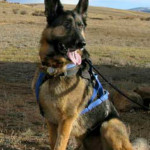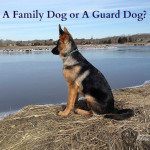The Risks of Tethering
NOTE: The opinions expressed in this article are those of the author, and do not necessarily represent those of The Guild of Shepherds & Collies. We do not take an official stance on tethering one way or the other. Feel free to express your own views by signing up to our email list. We'd love to know what your thoughts are. Healthy conversation is encouraged and helps make the community stronger.
The Risks of Tethering
On a crisp, fall afternoon, four German Shepherd Dogs romp on a beautiful hillside in Northern California. The pack runs amok in the fenced yard while chasing squirrels and each other without skipping a beat. Strong, handsome and agile, the Shepherds could be mistaken for military working dogs on holiday, except for one thing – or rather three things; each dog is missing a rear leg.
Codie Rae, Travis Ray, Austin Ray and Wyatt Ray are the “Oaktown Pack,” a quartet of four German Shepherd Dogs all saved from a life of neglect on the mean streets of Oakland in Northern California. Throughout the last eight years, each of these beauties was brought into the local German Shepherd Dog rescue with extensive rear leg injuries that necessitated amputation. Rescue personnel don't know exactly how Codie, Travis and Austin's limbs became so mangled but they have their suspicions: in all likelihood they were tethered dogs who escaped horrible situations, just like their pack mate, Wyatt Ray.
Suffering the “Guard Dog” Fate
Being left alone and ignored in a backyard is a terrible life for any dog, especially for the highly intelligent German Shepherd Dog. Strong and confident, with an intelligence that outshines most breeds, the German Shepherd Dog who is raised with a capable pack leader will become a brilliant and dedicated companion for life. Sadly, too many German Shepherd Dog puppies are purchased by people who don't have the patience or training for the breed. When these adorable little puppies grow up without training and appear to be out of control, the neglectful owner often banishes the dog to a life of back yard isolation and often, permanent tethering.
In July 2009, eight month old Wyatt, then known as “Chopper”, also met this terrible fate. One day he was taken to an Oakland vet clinic by his owners because “something was wrong with his leg,” they told the staff. The limb had already lost circulation and gangrene was setting in when the owners feigned ignorance about how it happened. The vet was not convinced of their story as he had seen this situation all too often in the rougher parts of Oakland, where many homes have a “guard dog” on a chain. To the vet, it was obvious what transpired: Chopper's leg had been strangled by a tether.
Just like Rocky the German Shepherd, who chewed his own foot off to escape his back yard fate, Chopper's leg would need to be amputated to save his life. The owners declined and told the vet, “we don't want a three-legged Shepherd, put him down.” The vet refused, however, and persuaded the owners to relinquish the dog. A kind vet tech called the German Shepherd Rescue of Northern California and after his amputation surgery, the young dog was on his way to a new life as “Wyatt Ray.” Wyatt Ray became the third three-legged member of the Oaktown Pack and spokesdog for Tripawds.com, the world's largest support community for animal amputees.
Anti-Tethering Awareness Gives Dogs a Leg to Stand On
Until recently, most people didn't give chaining or tethering a second thought, but now organizations like the Humane Society of the United States are increasing public awareness about the psychological and physical damage caused by the improper, routine use of tethering.
“Dogs are naturally social beings who thrive on interaction with human beings and other animals,” the Humane Society states on their website. “A dog kept chained in one spot for hours, days, months or even years suffers immense psychological damage. An otherwise friendly and docile dog, when kept continuously chained, becomes neurotic, unhappy, anxious and often aggressive.”
Herding breed dogs are highly social, adaptable breeds who require constant human contact. When banished to a backyard tether and left alone without close, consistent interaction for any length of time, herding breeds (or any dog, for that matter) will quickly become destructive and anxious, often displaying compulsive behaviors typical of human mental illness patients. Tethered dogs like Wyatt often suffer traumatic injuries when their leg gets caught up in the tether. If the dog is lucky enough to find a new home, he will bring along hefty emotional baggage, too.
It's unclear how many dogs lose their leg this way, but if amputee dogs like Wyatt, Rocky, Joseph and the Oaktown Pack are any indication, there is still a huge population of improperly tethered dogs in this world. The next time you see any dog tethered to an object, remember that a majority of states have specific limitations on the use of tethering such as: type of tether used, length of time the dog is tethered and the weather conditions.
Article By:
Rene Agredano
Tripawds
From The Guild of Shepherds & Collies Evangelists:
In addition to the information provided above, our Evangelists and staff would like to offer a few additional insights and resources to further educate our community on the use of tethering. As stated previously, The Guild of Shepherds and Collies does not take sides on this matter. Our goal is to educate our community and provide topics of discussion. As this article takes one side, we are offering (factual) information on the other side. We encourage our members to create a healthy discussion on this topic and ask that it be kept civil , keeping in mind we are all here for the same reason - we all love our herding breed dogs and want to provide the best for them. Everyone is entitled to his or her own opinions.
While the Humane Society of the United States supports an anti-tethering movement and the link given in the article above generally leads people away from the use of tethering, they also point out that it’s the improper use of tethering, such as continuous use and the neglect that typically occurs with the use of tethering, not tethering itself, that is harmful to dogs.
One of our Evangelists offered the use of tethering in a positive light - for training purposes. When a dog is tethered to its owner, he or she can learn a variety of positive behaviors, as well as establish bonding for new puppies.
In some communities, fences are forbidden, so residents utilize pulley runs by their doors to quickly allow their dog to have some much needed exercise and time outside, and of course, go to the bathroom. This is a great example of how to use tethering in a safe and effective manner.
One final thought: The term “tethering”, as used in this article, is not used for when dogs are on hand-held leashes. This article uses the term for when a person ties a dog with a rope or line to a stationary object.
Helpful Resources on Proper Tethering and Laws on Tethering:
Anti-Chaining Laws by State, February 2015
Table of State Dog Tether Laws, 2014
RSPCA, Can Dogs Be Safely Confined By Tethering?






